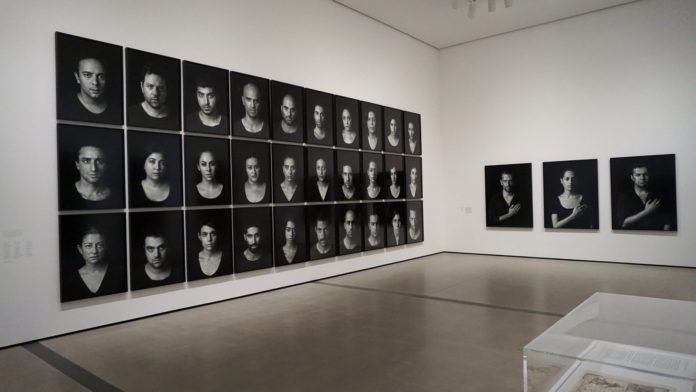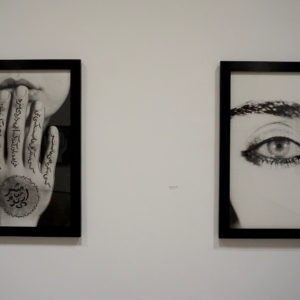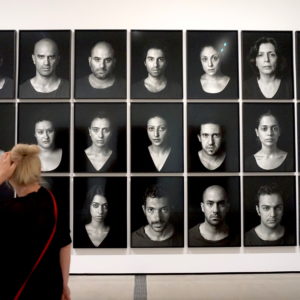
At the Broad’s new survey of the Iranian artist Shirin Neshat, images of resistance, faith and exile take center stage in a career-spanning exhibition. Titled “Shirin Neshat: I Will Greet the Sun Again,” the show displays the largest-ever exhibition of Neshat’s work and offers a poignant reflection on its themes.
A native of Iran, Neshat left the country at age 17 to study art in the United States, but the turmoil and fallout of the Iranian Revolution prevented her from returning for nearly 20 years. Neshat’s exile from Iran and the impact of the revolution have informed her work throughout her career, even as she expands her work to explore regions beyond Iran.
Neshat’s survey presents a welcome departure from the Broad’s permanent collection, located two floors above “I Will Greet the Sun Again.” Whereas the Broad’s collection is biased toward painting and sculpture, Neshat works in film and photography. The exhibit covers approximately 30 years of Neshat’s career and includes 230 photographs and eight video installations, most of which appear in black and white. The focus on photography also presents a pleasant contrast to the offerings of the Broad’s neighbor, the Museum of Contemporary Art (MOCA) on Grand Avenue, where current exhibits “With Pleasure” and “Open House: Gala Porras-Kim” also consist of paintings and sculptures.
Moving in chronological order, visitors follow Neshat’s career in her home country of Iran through to her emigration to the U.S. in the wake of political instability caused by the Iranian Revolution. Neshat’s art frequently considers the role of women within Iranian society and religion, as well as the general themes of resistance, exile, isolation and hope.
At “The Logic of Poetry and Dreams” event Nov. 7, associate director for events and programs Darin Klein of the Broad said Neshat pulls from Iranian poetry and visual culture, and that the union of the two is reflected in her photos and films. The event was one of several in a series in which the Broad invites artists to perform and reflect upon Neshat’s works.
According to Majid Naficy, an Iranian poet who performed at the event, the title of the exhibit further reflects Neshat’s interest in poetry. Naficy said the name “I Will Greet the Sun Again” comes from a poem by Forugh Farrokhzad, who he called one of the most important contemporary Iranian poets.

The show highlights the importance of poetry in its first room with Neshat’s “Women of Allah” (1993-1997) series, an early example of Neshat’s combination of photos with texts and patterns. For example, “Untitled” (1996) utilizes an excerpt from Farrokhzad’s poem “I Pity the Garden” both as decoration and as a means of highlighting the contrast between the image of the veiled woman and the words of a poet recognized for her outspokenness. The photo features a black- and-white close-up image of a woman’s decorated hand as it covers her mouth.
“Book of Kings (2012),” a monumental three-part photo portrait series by Neshat, also stands out as a commentary on the struggle between a populace and those in power. The series consists of three sections — the “Masses,” the “Patriots” and the “Villains” — that form a narrative spanning an entire room. On one side of the room are the three Villains, imagined as a patriarchal trio of older men. Directly opposite them faces a wall showcasing the Masses. Consisting of a diverse grouping of 30 young individuals, the Masses stare confrontationally at the opposing Villains. Everyone appears in Neshat’s trademark black-and-white color scheme, with the occasional punctuation of red adding visual flair. The scale of the series, combined with Neshat’s exceptional and poignant photography, makes for a must-see in the exhibit.

While the many video installations are engaging works, they each range from approximately 10–30 minutes in length. To watch all of them would demand several hours in the exhibit — more time than most visitors may be able to devote. Such an issue may be more forgivable were the exhibit free and more available to visitors, but the Broad charges $20 for admission to the exhibit except on Thursdays from 5-8 p.m.
Visitors will also need to decide beforehand whether “I Will Greet the Sun Again” is for them. Compared to the colorful offerings of the Broad’s free exhibits, such as the flashy Jeff Koons and Andy Warhols, Neshat’s works could appear dull. Visitors interested in the perfect Instagram photo will find themselves sorely out of place amidst Neshat’s work, and down a few dollars as well. This in no way decreases the quality of Neshat’s work, but visitors should reflect on why they want to see exhibit.
For those willing to invest the time, energy and money, “I Will Greet the Sun Again” rewards visitors with a profound reflection on resistance, religion and isolation. Neshat’s work shines brightly and offers something unique for those who seek it.
“I Will Greet The Sun Again” continues until Feb. 13, 2020.
![]()



































